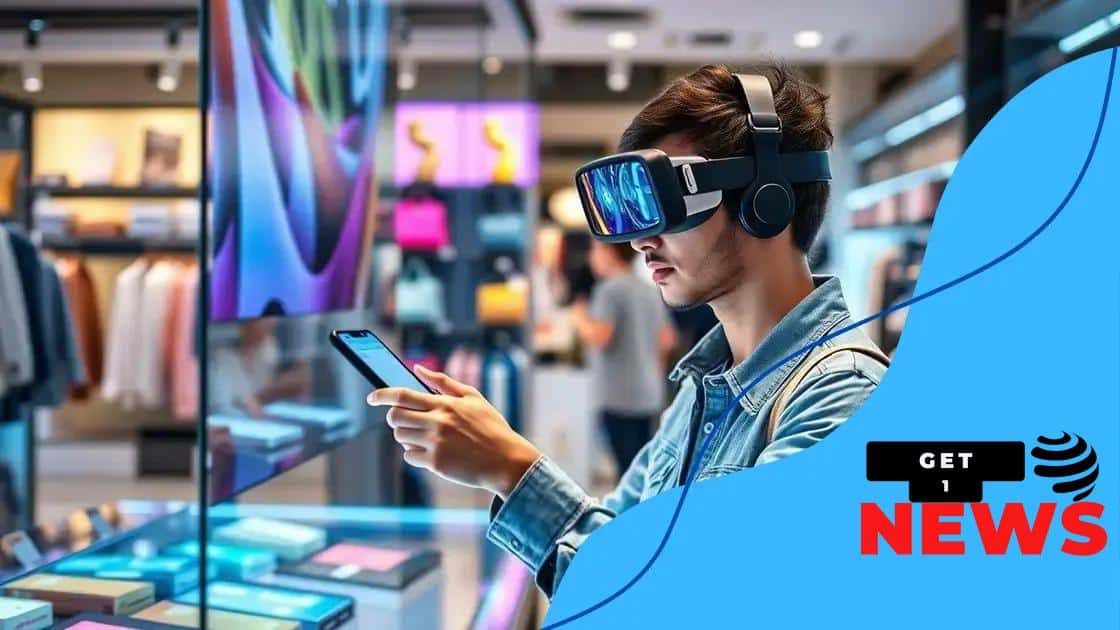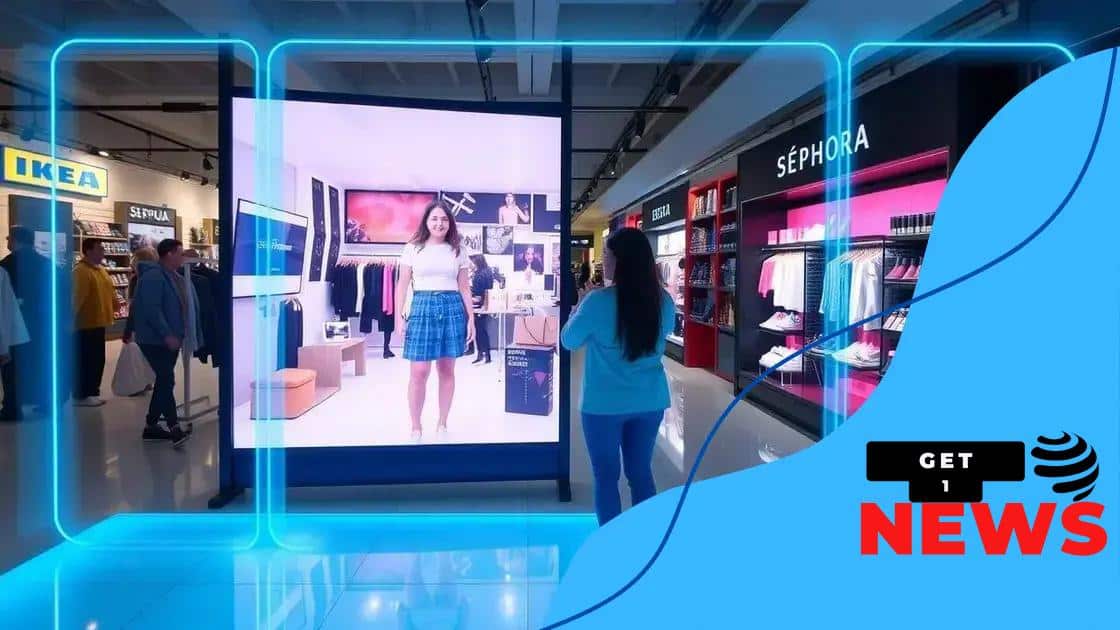Augmented reality in retail customer experience

Augmented reality in retail transforms shopping by providing immersive experiences, allowing customers to visualize products in their environment, leading to informed decisions and enhanced customer engagement.
Augmented reality in retail customer experience is changing the game for shoppers and brands alike. Imagine walking into a store where products come to life through your phone, allowing for a unique interaction that traditional shopping just can’t match. Curious how this impacts your shopping habits?
Understanding augmented reality technology
Understanding augmented reality technology is essential for appreciating its role in retail. This technology bridges the gap between the digital and physical worlds, offering new ways to interact with products and brands.
Augmented reality allows customers to visualize products in their real-world environment. Imagine being able to see how a piece of furniture fits into your living room right from your smartphone. This immersive experience transforms how shoppers make purchasing decisions.
Key Components of Augmented Reality
There are several key components that make augmented reality technology work effectively:
- Computer Vision: Enables devices to recognize and interpret real-world objects.
- Depth Tracking: Helps determine the distance between the user and objects in the environment.
- Display Technology: The means by which virtual content is rendered onto the user’s view, often through devices like smartphones, tablets, or AR glasses.
As the technology evolves, brands are increasingly leveraging it to enhance user experience. From virtual try-ons for clothing to interactive displays in stores, the possibilities are endless. Retailers can now provide a unique blend of convenience and engagement.
Benefits for Retailers
Implementing augmented reality can significantly benefit retailers:
- Increased customer engagement through interactive experiences.
- Improved conversion rates as customers can visualize products better.
- Stronger brand loyalty as shoppers appreciate innovative solutions.
Retailers must understand how to integrate this technology into their strategy effectively. By familiarizing themselves with the tools and techniques available, they can remain competitive in an ever-evolving market. With customers seeking more personalized shopping experiences, augmented reality will be a crucial part of future retail.
How augmented reality enhances shopping experiences
How augmented reality enhances shopping experiences is a fascinating topic. This technology allows customers to interact with products in a more immersive way, making shopping feel engaging and personalized.
When customers can see how an item looks in their own space, it changes the way they buy products. With augmented reality, shoppers can visualize furniture in their living rooms or clothes on themselves without needing to physically try them on. This unique capability makes online shopping more efficient and enjoyable.
Immersive Try-Ons
Retailers are using augmented reality to create immersive try-on experiences. For example:
- Virtual fitting rooms: Customers can see how clothes fit through their smartphone cameras.
- Makeup applications: Beauty brands allow users to “try on” makeup virtually before purchase.
- Eyewear simulations: Customers can view how glasses look on their faces without visiting a store.
This not only saves time but also reduces returns, as customers can make informed choices. The thrill of trying something on virtually keeps shoppers returning to brands that feature augmented reality.
Enhanced Product Information
Augmented reality also enhances product information. Traditional labels can be limiting, but AR offers so much more. Imagine scanning a product with your phone and getting detailed information about its features, reviews, and usage tips right on your screen.
This interaction can elevate a customer’s confidence in their purchase. They can learn about sustainability practices or view videos demonstrating product usage. With such engaging content, customers are more likely to feel satisfied with their choices.
The integration of augmented reality into retail goes beyond mere gimmicks. It creates a richer shopping journey, making it easier for customers to connect with products on a personal level. Customers appreciate retailers that embrace such innovations.
Examples of retailers using augmented reality

Many retailers are utilizing augmented reality to create unique shopping experiences. These examples showcase how brands are adapting to meet consumer demands through innovative technology.
One of the leading examples is IKEA. Their app allows customers to visualize how furniture pieces fit in their homes. Users can place a virtual sofa or table in their living room using their smartphones. This experience helps shoppers make more informed decisions.
Sephora’s Virtual Artist
Another great example is Sephora. Their Virtual Artist feature lets customers try on makeup virtually. Using augmented reality, shoppers can see how different shades of lipstick or eyeshadow look on their skin tone. This feature enhances the online shopping experience and reduces the need for in-store visits.
Adidas’ AR Shopping Experience
Adidas has also embraced augmented reality. They launched interactive experiences in their stores, allowing customers to scan shoes to receive information about them. Customers can unlock exclusive offers or access personalized styles. This interactivity enhances engagement and encourages purchases.
Retailers like Nike are using AR for special in-store events. They create unique experiences, such as launching new products that incorporate augmented reality games. These engaging interactions drive foot traffic and boost sales.
Leading brands are leveraging augmented reality not just to sell products but to create memorable and personalized shopping experiences. As technology continues to evolve, more retailers will find innovative ways to integrate AR, shaping the future of shopping.
Benefits for consumers and retailers
The benefits of augmented reality for consumers and retailers are significant. This technology enriches the shopping experience for buyers while helping businesses increase sales and customer loyalty.
For consumers, one of the main advantages is the ability to see products in a real-world context. For instance, shoppers can visualize how furniture will look in their home before making a purchase. This reduces uncertainty and helps customers make informed decisions.
Enhancing the Shopping Experience
Augmented reality can make shopping more engaging by providing:
- Interactive features: Customers can interact with products in an immersive way.
- Instant access to information: Shoppers can receive product details, reviews, and recommendations with just a scan.
- Personalized experiences: AR can tailor suggestions based on individual preferences and past purchases.
This personalized approach not only boosts customer satisfaction but also drives sales. When consumers feel connected to a brand, they are more likely to return and recommend it to others.
Benefits for Retailers
Retailers also gain numerous benefits by incorporating augmented reality into their strategies. They can enhance their brand image and differentiate themselves in a crowded market. Moreover, they can:
- Reduce return rates: When customers can visualize their purchases, they’re less likely to return items.
- Increase conversion rates: Engaging shopping experiences can lead to higher sales.
- Gather valuable data: Retailers can collect insights on consumer behavior to refine their offerings.
By leveraging augmented reality, retailers can meet the evolving expectations of modern consumers. As technology continues to advance, the integration of AR will shape the future of shopping for both consumers and retailers alike.
Future trends in augmented reality for retail
The future trends in augmented reality for retail are shaping how consumers interact with products. As technology evolves, we can expect even more innovative applications that enhance the shopping experience.
One key trend is the integration of artificial intelligence with augmented reality. This combination will enable retailers to offer personalized shopping experiences. For instance, AI can analyze customer preferences and recommend products through augmented reality, making the shopping experience more tailored and efficient.
Increased Use of AR in Mobile Apps
More retailers are likely to develop mobile apps featuring augmented reality capabilities. These apps will allow customers to try on products virtually from anywhere. Imagine browsing through your favorite brands on your phone and seeing how a pair of shoes looks on your feet before buying them. This convenience will drive more sales through mobile platforms.
Virtual Showrooms
Another exciting trend is the rise of virtual showrooms. Retailers can create immersive environments where shoppers can explore products in a 3D space. This allows customers to interact with products as if they were in a physical store, providing a unique experience that blends online and offline shopping.
Additionally, social media platforms are incorporating augmented reality features. Users will be able to shop directly through AR experiences on platforms like Instagram and Snapchat. This trend will blur the lines between content and commerce, making shopping more engaging and accessible.
As augmented reality technology improves, we can also expect advancements in its accessibility. Devices like AR glasses may become more mainstream, allowing shoppers to experience augmented reality without needing a smartphone or tablet. This would enhance the retail experience and open up new possibilities for interaction.
The future of augmented reality in retail is brimming with potential. Retailers that embrace these trends will likely enhance customer engagement and remain competitive in a fast-changing market.
In conclusion, the future of augmented reality in retail is bright and full of possibilities. As technology continues to advance, both consumers and retailers will benefit from more personalized and immersive experiences. Retailers that embrace these innovations will not only attract more customers but also enhance their shopping journey. The integration of augmented reality will play a crucial role in shaping how we shop, making it more engaging and efficient in ways we have yet to imagine. 🌟
FAQ – Frequently Asked Questions about Augmented Reality in Retail
How does augmented reality improve the shopping experience?
Augmented reality enhances the shopping experience by allowing customers to visualize products in their environment, making informed decisions and reducing uncertainty.
What are some examples of retailers using augmented reality?
Retailers like IKEA, Sephora, and Adidas use augmented reality to allow customers to try on products virtually or visualize how items fit in their space.
Is augmented reality technology accessible for all types of retailers?
Yes, augmented reality technology is becoming more accessible, with many tools and platforms available for retailers of all sizes to integrate AR features.
What trends can we expect in the future with augmented reality in retail?
Future trends include more personalized shopping experiences, the rise of virtual showrooms, and the integration of AR features on social media platforms to enhance online shopping.





